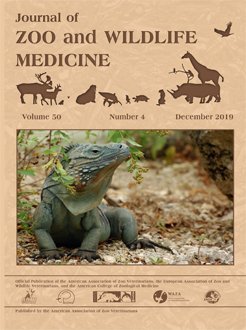Avipoxvirus infections have been reported in both free-ranging and domestic birds worldwide. Fowlpox and canarypox viruses belong to the genus Avipoxvirus among the virus family Poxviridae. They cause cutaneous lesions with proliferative growths on the unfeathered parts of the skin and/or diphtheritic lesions generally associated with necrosis in the upper respiratory and digestive tracts. In this study, a poxvirus has been identified in wild-caught snow buntings (Plectrophenax nivalis) housed in an outdoor aviary in the region of Rimouski, Quebec. During the falls and winters of 2015 and 2016, eight snow buntings affected by this infection were examined. Macroscopic and microscopic lesions observed were characteristic of an avipoxvirus infection. Electron microscopy imaging of an ultrathin section of the histopathological lesions of two birds confirmed the presence of the poxvirus. Afterward, the presence of the poxvirus was confirmed in three birds by a specific polymerase chain reaction assay that amplified a segment of the gene encoding the fowlpox virus 4b core protein. A 576-nucleotide amplicon was obtained from one of them and sequenced. The analyses revealed a 99% homology to other previously described avipoxviruses. Using high-throughput sequencing, almost the entire viral genome of this avipoxvirus was revealed and found to possess a 359,853-nucleotide sequence in length. Bioinformatic analyses revealed that the virus was genetically related to canarypox virus. To our knowledge, this is the first confirmed case and full description of a poxviral infection in this species. This episode suggests a high susceptibility of this northern species of passerine to avipoxviruses circulating in southeastern Canada during the summer months. Even if the source of the viral infections remains undetermined, transmission by local biological vectors is suspected. Management of poxviral infections in snow buntings housed outdoors in southeastern Canada could rely on the control of biting insects.
How to translate text using browser tools
9 January 2020
WHOLE GENOME SEQUENCING OF AN AVIPOXVIRUS ASSOCIATED WITH INFECTIONS IN A GROUP OF AVIARY-HOUSED SNOW BUNTINGS (PLECTROPHENAX NIVALIS)
Rozenn Le Net,
Chantale Provost,
Christian Lalonde,
Lyette Régimbald,
Francois Vézina,
Carl A. Gagnon,
Stéphane Lair
ACCESS THE FULL ARTICLE
avipoxvirus
Canarypox
pathology
Plectrophenax nivalis
pox
Snow Bunting
whole genome sequencing





